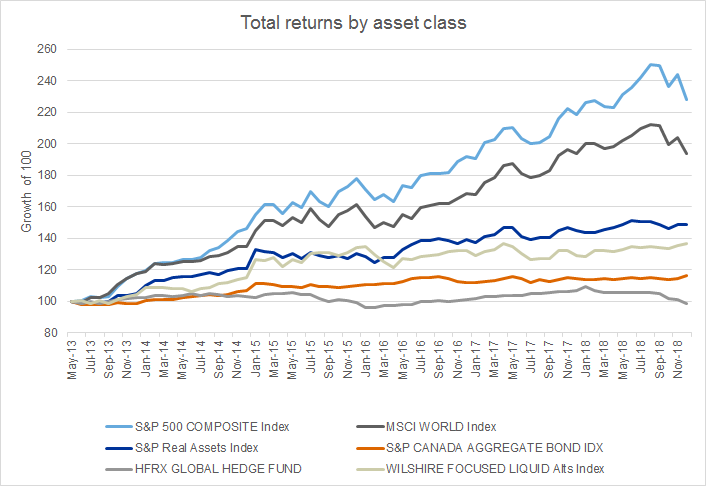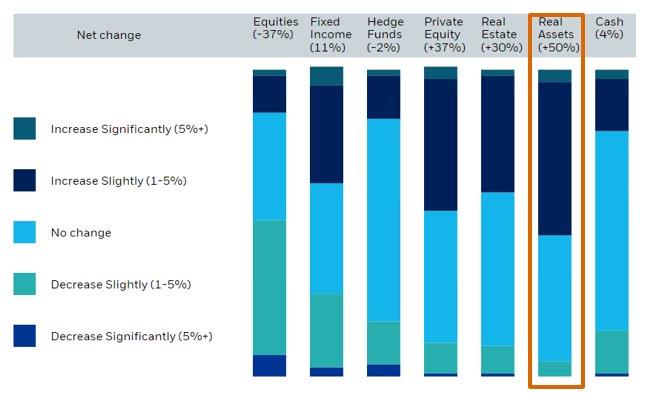Real Assets: The “Alternative” Liquid Alternative
As liquid alternative funds become available for retail investors in Canada this year, advisors will need to exercise proper due diligence and caution before diving into this space. Liquid alternative funds (liquid alts) are typically alternative “hedge fund-like” strategies and asset classes offered through a mutual fund prospectus. A practical way to make sense of this new landscape is to examine the two types of approach – one that uses alternative assets and another that uses alternative strategies. Each approach uses different techniques to pursue a common outcome: enhance portfolio diversification and improve risk-adjusted returns for investors.
Alternative assets typically provide access to investments that have a low correlation to traditional stocks and bonds, and include asset classes such as Real Assets, Listed Infrastructure, Commodities, Real Estate Investment Trusts (REITs) and Private Equity.
Alternative strategies, under the new regulations on liquid alternatives, are now accessible to all investors and include strategies such as currency, long/short equity, managed futures, market neutral, momentum, global macro and volatility.
While alternative strategies can play a role in portfolios, advisors should be careful as performance is typically exclusively driven by manager skill and the outcomes can vary dramatically based on strategy selection. Choosing the right one requires substantial due diligence and oversight.
Although alternative strategies have diversification benefits, at Russell Investments, we believe alternative assets also offer the opportunity to improve risk-adjusted returns. For the purposes of this discussion, we will focus on Real Assets, such as listed infrastructure, listed real estate, commodities and real return bonds.
Liquid Alts vs. Listed Real Assets
Liquid alternative funds have been available to U.S. retail investors for a number of years and we can look to this experience for insight into how these funds have performed against Real Assets. These funds are frequently referred to as '40 Act Funds’ based on the legislature that allows hedge fund-like strategies to be offered through pooled investment vehicles.
As Exhibit 1 shows, over the past five years Real Assets have outperformed hedge funds and liquid alternative strategies. We will use the S&P Real Assets Index as a representation of the following four asset classes: listed infrastructure, listed real estate, commodities and real return bonds.
Exhibit 1: Returns by asset class

Source: Thomson Reuters Datastream, May 31, 2013 to December 31, 2018. Rebased to 100. In CAD. S&P 500 Composite represents large cap U.S. equity, S&P Real Assets Index represents real assets, HFRX Global Hedge Fund represents global hedge funds, MSCI World Index represents global equities, S&P Canada Aggregate Bond Index represents Canadian bonds, Wlishire Focused Liquid Alt represents a basket of liquid alternative funds. Indexes are unmanaged and cannot be invested in directly. Past performance is not indicative of future results.
The Wilshire Focused Liquid Alts Index (Wilshire) provides a lens into the U.S. experience with “40 Act” liquid alt funds. The index measures performance of a focused basket of liquid alt funds that provide exposure to equity hedge, global macro, relative value and event driven alternative strategies. Looking back, since the launch of Russell Investments Real Assets portfolio*, both the Global Hedge Fund Index (HFRX) and the Wilshire Index have dramatically underperformed the broader market and listed Real Assets. This is only a reflection of the last five years, but if we are to look back even further over 10 years, the S&P Real Assets Index posted a return of 6.48% while the Wilshire Index returned 2.16% annualized.
*Inception date of Russell Investments Real Assets May 22, 2013
Why Real Assets?
Real Assets provide investors with access to typically liquid assets such as real estate, infrastructure and commodities through publicly traded securities. Real Assets have historically helped diversify the risks of traditional stocks and bonds and achieve an improved risk-adjusted return. The core attributes that make Real Assets an attractive long-term allocation to client portfolios are:
- Enhanced Portfolio Diversification – Real Assets offer investors meaningful diversification with distinct return drivers through sectors that tend to pay off at different times in the market cycle, compared to traditional stocks and bonds. As an example, real assets, infrastructure and real estate have exhibited “defensive” characteristics and have tended to outperform broader equity markets during negative equity market environments. For example, consider Q4 2018, a period where most major indexes experienced sizeable selloffs. During this period, Russell Investments Real Assets, Russell Investments Global Infrastructure Pool and Russell Investments Global Real Estate Pool provided significant downside protection.
October 1, 2018 to December 31, 2018
- Income potential – Real Assets have historically provided higher yields than both Canadian bonds and equities. Adding these strategies to portfolios can help enhance the income investors are finding difficult to obtain from traditional bonds, without adding the same level of volatility as the broader equity market
- Inflation Protection – Real Assets can provide protection against the potentially damaging effects of inflation over time, versus a portfolio concentrated only in traditional stocks and bonds.
| Asset Class | 4Q18 Return |
|---|---|
| Global Equities (MSCI World Index) | -9.31% |
| Canadian Equities (S&P/TSX Composite Index) | -10.79% |
| US Equities (Russelll 3000 Index) | -9.33% |
| Russell Investments Real Assets | -1.27% |
| Russell Investments Global Real Estate Pool | -0.53% |
| Russell Investments Global Infrastructure Pool | 0.74% |
Conclusion – Institutional Style Portfolio Construction
The advent of liquid alternatives is perhaps the most exciting regulatory development in the Canadian mutual fund industry in a long time. Many mutual fund companies are preparing for and have launched products in this space. Russell Investments believes liquid alternatives can be a viable option for some investors who are comfortable with risk. However, we believe Real Assets can provide benefits for investors who may not be as comfortable with risk.
Our analysis shows that listed Real Assets may be as effective in enhancing the risk/return profile of client portfolios without venturing too far into the complex world of alternative investing strategies. For these reasons, we see institutional investors continuing to diversify their large pension plans and endowments by increasing their exposure to Real Assets. Exhibit 3 highlights the expected portfolio shifts in 2019 by institutional investors worldwide, based on a survey by global investment firm Blackrock.
Exhibit 3: Global institutions rebalancing intentions
Equities, Alternatives and Cash

Source: Blackrock 2019 Global Institutional Rebalancing Survey; based on a survey of 230 institutional clients representing more than US$7 trillion in investible assets.
Based on the attractive attributes of Real Assets, it’s not surprising that many institutional investors are using listed real assets to complement their portfolios. Having said that, many individual investors still remain dramatically under-allocated to this important asset class.
As you begin to dig through the tsunami of Liquid Alts product launches, ask yourself, what is the outcome you are trying to achieve in allocating to these strategies and what level of risk are you willing to accept? While both alternative assets and alternative strategies can play a role in client portfolios, at Russell Investments, we believe that Real Assets can be an effective way for investors to diversify sources of risk and return, leading to potentially better absolute returns and lower volatility.